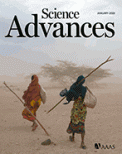2019
Type(s)Journal Article
AuthorsNetanel Tzarum, Erick Giang, Leopold Kong, Linling He, Jannick Prentoe, Elias Augestad, Yuanzi Hua, Shaun Castillo, Georg M. Lauer, Jens Bukh, Jiang Zhu, Ian A. Wilson and Mansun Law
SourceScience Advances 02Jan 2019:eaav1882
Urlhttp://advances.sciencemag.org/content/5/1/eaav1882
BibtextBibTeX
Abstract:
An effective vaccine to the antigenically diverse hepatitis C virus (HCV) must target conserved immune epitopes. Here, we investigate cross-neutralization of HCV genotypes by broadly neutralizing antibodies (bNAbs) encoded by the relatively abundant human gene family VH1-69. We have deciphered the molecular requirements for cross-neutralization by this unique class of human antibodies from crystal structures of HCV E2 in complex with bNAbs. An unusually high binding affinity is found for germ line–reverted versions of VH1-69 precursor antibodies, and neutralization breadth is acquired during affinity maturation. Deep sequencing analysis of an HCV-immune B cell repertoire further demonstrates the importance of the VH1-69 gene family in the generation of HCV bNAbs. This study therefore provides critical insights into immune recognition of HCV with important implications for rational vaccine design.

